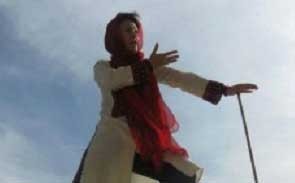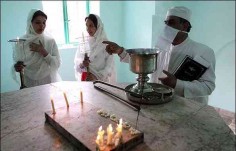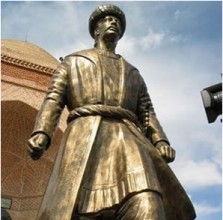The first female carrier – Iranian Shahnameh reader + Pictures
Naqali and Shahnameh Khoani are known as coffee houses, so that during the Safavid era, coffee houses were the gathering centers for people of taste and poetry.. Little by little, with the intervention of Shah Abbas in the affairs of coffee houses and his presence in the gathering of Shahnameh readers and exchanging opinions with poets, coffeehouses gradually become a suitable place for storytellers and Shahnameh readers. He is one of the painters who has turned to the art of painting professionally since 1375.
While two years have passed since the registration of Naqali and Shahnameh reading as Iran's spiritual heritage in UNESCO, small and big problems are threatening this ancient Iranian ritual. It is stated and it is said that during the time of Ferdowsi, four narrators of the Shahnameh were engaged in this art, but the prosperity of this art and the closeness of reading the Shahnameh to the narrators are known since the time of the Safavid kings, when coffee houses were formed in Iran..
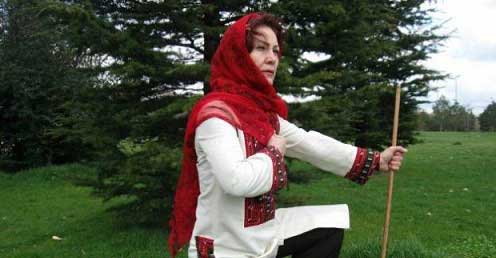 Experts of Iranian dramas believe that to explore the history of drama in pre-Islamic Iran, it is important to pay attention to ritual dramas, marquee plays and especially "Naqali" and among the non-religious dramas of Iran that existed until half a century ago. It had a warm market, Naqali should be mentioned. Bahram Bayzaei writes in the definition of Naqali: "Naqali is the narration of an event or story, in poetry or prose with gestures and moods and appropriate expression in front of the crowd." Naqali and Shahnameh reading are known as coffeehouses, as during the Safavid era, coffeehouses were the gathering place for people of taste. And it was poetry. Little by little, with the intervention of Shah Abbas in the affairs of coffee houses and the presence of Shahnameh readers and exchanging opinions with poets, coffee houses gradually become a suitable place for storytellers and Shahnameh readers..
Experts of Iranian dramas believe that to explore the history of drama in pre-Islamic Iran, it is important to pay attention to ritual dramas, marquee plays and especially "Naqali" and among the non-religious dramas of Iran that existed until half a century ago. It had a warm market, Naqali should be mentioned. Bahram Bayzaei writes in the definition of Naqali: "Naqali is the narration of an event or story, in poetry or prose with gestures and moods and appropriate expression in front of the crowd." Naqali and Shahnameh reading are known as coffeehouses, as during the Safavid era, coffeehouses were the gathering place for people of taste. And it was poetry. Little by little, with the intervention of Shah Abbas in the affairs of coffee houses and the presence of Shahnameh readers and exchanging opinions with poets, coffee houses gradually become a suitable place for storytellers and Shahnameh readers..
After some time and with the prosperity of the coffee houses, Naqalan; In order to match the atmosphere with the stories they were telling, they read scrolls specific to each story and poems from Ferdowsi's Shahnameh with appropriate clothes and special movements.. This process continued until half a century ago, until social and cultural changes slowly spread the dust of oblivion on Naqali and coffee houses. It has been removed from the environment of coffee houses and there are even concerns about forgetting this ancient ritual.
The shadow of oblivion and vulgarity over the head of Iran's Naqali
What problem threatens Iran's Naqali these days? And what are the conditions of Naqali, an art that has been popular only in Iran?
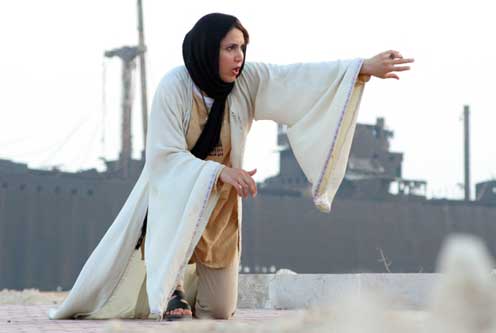
"Fateme Habibizad" known as "GardAfrid" is one of the porters trained in the school of Morshidan and Dervishan.. These days, he lives in Canada, but performs Naqali in English for non-Persian speaking audiences. He talks about the threats of the Naqali ritual: "Each art should have a place and an audience for presentation, fortunately the audience is very interested. But unfortunately there is no permanent place for this work in Iran. On the other hand, "Nada Afrid" considers the lack of a suitable place for Naqali as one of the threats to this art, which "Fateme Habibizad" known as "GardAfrid", who is also a trained Naqali in the school It is the gurus and dervishes, he mentions "abtish" as a threat to the art of Naqali.
"GardAfrid" explains about vulgarity in figurative art. But before that, he mentions the mentor "Waliullah Torabi" from the old Naqalan, who died a few months ago: "When Murshid Waliullah Torabi died, that's when I said that the death of this Murshid Naqali means the closing of a case and the end of an era and a school.. Because now that hangout is no longer the original hangout, that audience has changed and that space is no longer the old space.. Many things have changed, but in the meantime, in my opinion, Naqali is not being forgotten, it is going towards vulgarity.. I strongly see the problem of obscenity in Naqali and curtain reading.
Murshid Valiullah Torabi (Born in 1315 - Died in 1392)
This is how he describes vulgarity in Naqali: "Naghali has his own method and style of performance. It is defined based on specific movements and expressions. Telling stories with an epic plot. "Ben Mayeh Kalam is epic even if it is about topics like love and goats," adds this narrator.: "For example, a person performs a one-man show, which is called a performance, but it is not an impersonator, but it is called an impersonator.. Some people in the field of theater combine all of these into one, that is, they call curtain reading, prayer reading, fighting, etc. as Naqali.. While the general public knows well what is praise? Which is fasting? How is screen reading performed? What is iconography? Which one is reciting prayer and mendicancy? And finally, what do they call Naqali?
 He once again points to Murshid Tarabi and says: "Perhaps a naqal like Murshid Torabi knows all these things because he was a naqal, a purdah reader and a rozeh reciter, etc., but these days I hear that all these things are called naqali. These are vulgarities. All this is defined in Iranian folk culture.
He once again points to Murshid Tarabi and says: "Perhaps a naqal like Murshid Torabi knows all these things because he was a naqal, a purdah reader and a rozeh reciter, etc., but these days I hear that all these things are called naqali. These are vulgarities. All this is defined in Iranian folk culture.
"Saghi Aghili" known as "Nada Afrid" is one of the porters who has turned to the portmanteau art professionally since 1375. Registered in UNESCO as a heritage subject to destruction in 1390, the UNESCO organization also registered the portant art and Shahnameh reading of Iran. In the list of spiritual heritage, he emphasized that Naqali, as the oldest form of dramatic and live performance, which was introduced by Iran to the Spiritual Heritage Commission and registered in this list, is a work in danger of being forgotten that needs urgent material and spiritual support..
The report of UNESCO's spiritual heritage commission has discussed in five paragraphs the reasons for registering this work, its threatening conditions and the need to support it, and it has been mentioned that this art now needs financial assistance and support from the government and cultural groups. Things like, The destruction of traditional coffeehouses and its function in society, the formation and spread of new methods and tools of entertainment, the aging of the masters and elders of this traditional art and the reduction of their population among the young generation, which is an important factor in the degradation and reduction of skills. These are the most important reasons that, according to UNESCO, the survival of this historical and dramatic art is in serious danger..
The important goal of registering this work in the UNESCO report is to encourage people and government groups to focus on increasing awareness and information among the young generation of the society, through the introduction of this art with the help of educational institutions, schools and universities, this art of storytelling and style. its theatrical and artistic form will remain alive among the young generation.: "As far as I know, no government institution supports Naqali, but a few non-governmental institutions have done so, but it is not enough..
In response to another question, this porter woman says about the role of porters in preserving this spiritual heritage: "Naqals have always preserved and transmitted this heritage from chest to chest and sometimes in writing, my role is also not compassionate except for these veterans, and the expression of this statement is my way of conveying, which is mixed with drama, because the image is more attractive and lasting than speech in It is remembered that especially young people have received a unique welcome to this method.
"Fateme Habibizad" known as "GardAfrid" is one of the porters trained in the school of Murshidan and Dervishan.
"GardAfrid" also asked about "what institution is in charge of material and spiritual support for Naqali?" says: "There is no institution to support transporters. Like many traditional arts of Iran, which are without guardians, we do not have guardians in Naqali either. Documentary archiving has not been done in this field. All the documents are scattered in the archives of different people." He points to examples in this field and says: For example, Murshid "Syed Mustafa Saeedi" was a porter in the village of Yake Dange in Lorestan, or a porter lived with Tabhari in Khorasan, but no traces of these people have been recorded or there are very few.. For example, there is only a small voice of the mentor "Zariri Isfahani", while he was one of the unique people in the history of Naqali.
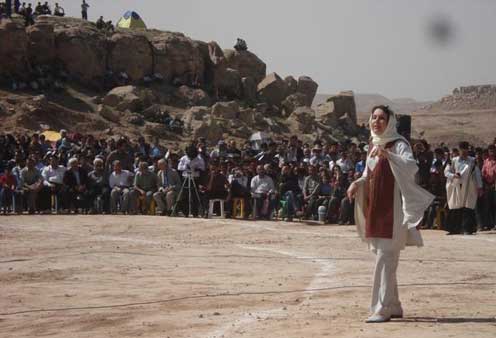 This delivery woman, who has been out of Iran for several years, says Del Cherkin: "One hand has no voice and this issue requires a collective effort. In the future, the only thing I can do is to sort out the petitions of the movers and advance the great encyclopedia I have in the field of movers, but these things also need support and investors."
This delivery woman, who has been out of Iran for several years, says Del Cherkin: "One hand has no voice and this issue requires a collective effort. In the future, the only thing I can do is to sort out the petitions of the movers and advance the great encyclopedia I have in the field of movers, but these things also need support and investors."
Transporter women in Iran; From Shahrzad's story-telling to Naqali in coffee houses
Everyone knows Shahrazad the storyteller. A storyteller who astonishes Shahryar with his skillful narration. Apart from Shahrazad, mothers were also a part of the narration of our childhood stories, which, beyond the tradition of Iranians, form a part of the world culture.. But how is it that with the deep roots of women's storytelling throughout human history, Naqali, this narrative and epic style, which is sometimes accompanied by emotional narratives, is a male act, and the mentors were always men, and the children of the mentors were also men who would become the future mentors..
Naqali, which is mostly known as Shahnameh reading, has been a part of the street culture tradition. The tradition through which the stories of Shahnameh were told among the people of the alleys and coffee houses, and due to the presence of men in these circles, has become a male tradition, and maybe because of this, women could not play a role in retelling this story..
With the formation of a scientific view of popular culture and the creation of social debates in the recognition of this part of the human heritage, Naqali became a special narrative structure in Iranian drama art, and in this way, women succeeded in playing a role regardless of the public domain of the society. have in the way of performing this show.
Currently, many women are active in the field of acting, some of whom have turned to this ritual from the art of theater. Some people who have researched the history of Naqali, mention Ferdowsi's wife as one of the first female readers of the Shahnameh. On the other hand, some research shows that during the years of the Iranian revolution, a porter named Farhanaz Karimkhani was porter in some public spaces..
Also, considering that according to some historical documents, the name "Naqali" has been around for about four centuries. Before that, it was known as "Khaniagari" which is a story-telling with musical instruments and singing, so some believe that the history of Iranian female narrators goes back to the Sassanid era and a person named Azadeh, the Sasanian Khaniagar Bahram Gur..
Before the revolution, there was also a Naqali woman named Belqis. Belqis was a battle that went to the neighborhood of "Garrett Masin" (Smoke machine station) He used to come to Shush and recite. Murshid Belqis, who was a nagali before the revolution and continued his work for a few years after the revolution, but he could not do this work for a long time..
"Gard Afrid" in this regard, although he does not ignore the impersonation or courtship of women in the past, and of course he mentions Murshid Belqis in his interview with Kargarzaran newspaper in issue 534, but at the same time he talks about himself.: "I was the first woman who was educated in the coffeehouse, monastery and Zurkhaneh school. In fact, before I turned to Naqali, there was no woman who was educated in this school with the mentors.. We all know that in the past, women did not have such social conditions that they would want to engage in these types of activities that were carried out entirely in male environments, and fight or carry on.
He adds: "Always according to tradition, this cane, this scroll, this art and technique has been handed down to the son's disciple or to the son of that guru, but for many years I went to the monastery and the monastery for research, and of course I was not only a researcher, but also a disciple.. From those years, I did what a child mentor should do, until the mentors agreed to pass on their inheritance to me and gave me a transfer letter.. "They wrote a petition that I was the only female student who trained with these people."
Aghili, who is known as "Nada Afrid", also talks about his Naqali: "Since I was a child, I have been fond of this artistic heritage that has survived for a long time, and since then I used to paint in parties, but as a child and unprofessional, I started painting professionally in 1975 and taught art students to preserve this cultural art. "Um, I have also experienced simile training with two blind people."
He talks about the male view of Naghali religion: "From the point of view of some, narration is a man's job, but from my point of view, it is a woman's job, because mothers always tell and tell stories to their children, also, narration is not only speech, using body language helps to receive the narration and to That's why people all over the world can understand my speech in any language."
This carrier woman says: "Fortunately, there are more women porters than men, and this makes porters sweeter and more enjoyable.. Sometimes I hear that women's movers are canceled just because they are women and these restrictions put the movers in danger. I have also faced this limitation in Iran, but very little because I learned all the points that made my work. If they cancel, I would comply so that this does not happen, because I had and still have the duty to make people more familiar with the Shahnameh.
"Nada Afrid" also does narrations in English. He says about this: "I wanted to know the effect of reciting the Shahnameh on English speakers as well, it was well received in Turkey and Canada, especially in the Ottawa Storytelling Center and also among the YouTube audience." Ferdowsi himself has a poem in this context that says: "Anyone who reads the Shahnameh / if she were a woman, becomes a wrestler, or according to another version, anyone who reads the Shahnameh, whether male or female, becomes a wrestler" "GardAfrid" says about her problems as a female transporter to East Persia.: "I had Shahnameh and Naqali classes in Iran, which were mostly attended by women, and it seems that women's Naqali are now very popular in Iran, so that I have even heard that in recent years in Lernshin and Bakhtiari regions, women read the Shahnameh. and they don't have those previous troubles."
These days, the shadow of big and small threats is over Iran's narrators and Shahnameh readers. After two years of registering this spiritual heritage in UNESCO, which is unique to Iran and has never flourished in other Persian-speaking countries like Iran, what will happen to it?. These days, the heavy burden on the shoulders of women and men of Naqal, both inside and outside the country, as well as governmental and non-governmental support for this traditional ritual, is heavier than in the past..
Reference: http://url.parsiandej.ir/wingF
Articles recommended by us:
- Sindekht Abdali (Mrs. Naqal, reciting the Shahnameh) + Pictures
- music video (video) Reading the Shahnameh of Sindekht Abdali
- Conversation with Sindekht Abdali (The youngest lady reading Shahnameh)
- Naqali and Shahnameh reading


